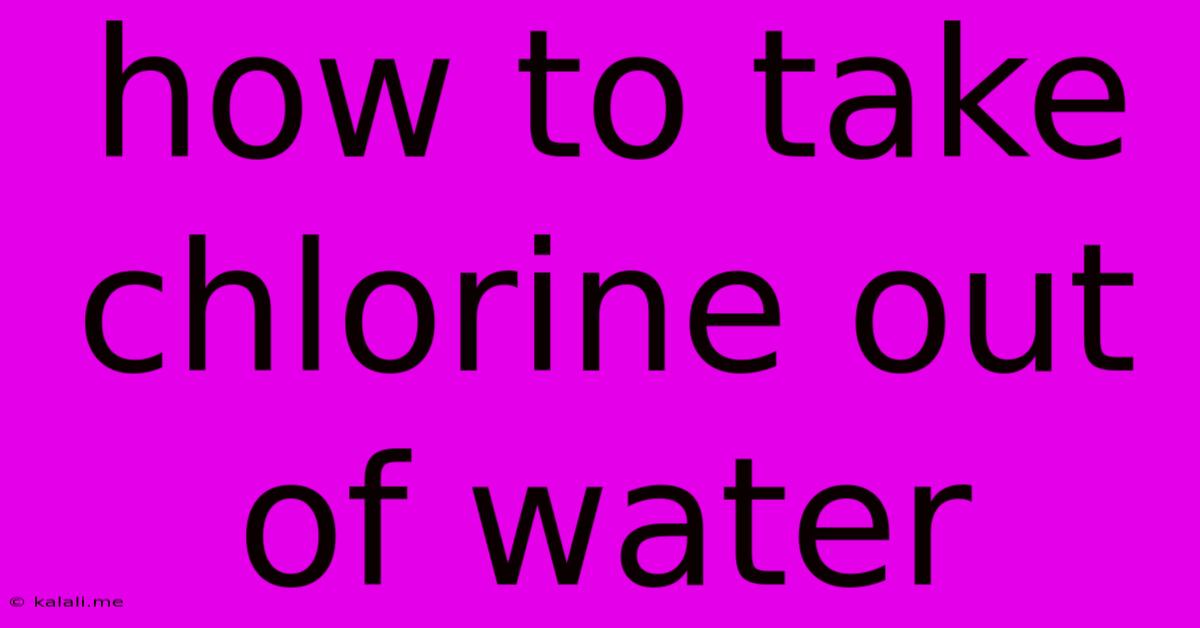How To Take Chlorine Out Of Water
Kalali
Jun 06, 2025 · 3 min read

Table of Contents
How to Remove Chlorine from Water: A Comprehensive Guide
Chlorine is commonly added to municipal water supplies to kill harmful bacteria and viruses. While effective for disinfection, chlorine can impart an unpleasant taste and odor to water, and some people are sensitive to its presence. This article explores several effective methods for removing chlorine from your water, ensuring a cleaner, healthier, and better-tasting beverage. Whether you're looking to improve the taste of your tap water or concerned about the potential health effects of chlorine, this guide will provide you with the knowledge and solutions you need.
Why Remove Chlorine from Water?
Several reasons exist for wanting to remove chlorine from your water. The most common include:
- Improved Taste and Odor: Chlorine's strong chemical smell and taste can significantly detract from the enjoyment of drinking water. Removing chlorine enhances the overall palatability.
- Health Concerns: While chlorine is generally safe at regulated levels, some individuals are sensitive to it and may experience skin irritation, respiratory problems, or other adverse effects. Removing chlorine minimizes potential exposure to these chemicals.
- Aquarium and Fishkeeping: Chlorine is highly toxic to fish and aquatic life. Removing chlorine from tap water before adding it to an aquarium is crucial for the survival of its inhabitants.
- Gardening and Plant Health: Chlorinated water can harm sensitive plants. Removing chlorine ensures the health and vitality of your garden.
- Better-Tasting Beverages and Cooking: Removing chlorine from water used in cooking and making drinks, such as tea and coffee, can significantly improve their taste.
Effective Methods for Chlorine Removal
Several methods can effectively remove chlorine from water. The best method for you will depend on your needs, budget, and the amount of water you need to treat.
1. Boiling: This simple method helps to remove chlorine, although it doesn't remove all of it. Boiling water for about 15 minutes will volatilize a significant portion of the chlorine. This method is suitable for small quantities of water.
2. Activated Carbon Filtration: This is a highly effective and popular method. Activated carbon filters, often found in pitchers, faucet attachments, or whole-house filtration systems, adsorb chlorine molecules, removing them from the water. These filters are readily available and relatively inexpensive. Remember to replace the filter cartridges regularly according to the manufacturer's instructions for optimal performance.
3. Air Exposure: Leaving water in an open container for a few hours allows chlorine to dissipate into the air through a process called aeration. This method is less effective than filtration but can be useful for small quantities of water, and it's a completely free option. This works best if the water is shallow and exposed to a breeze.
4. Vitamin C (Ascorbic Acid): This chemical compound reacts with chlorine, neutralizing it. Add a few drops or a pinch of Vitamin C powder to your water, let it sit for a few minutes, and then consume. However, this method only works for small amounts of water and might slightly alter the water’s taste.
5. Sodium Thiosulfate: This chemical compound is specifically designed for chlorine removal and is often used in aquariums. It neutralizes chlorine quickly and effectively. However, it’s important to use the correct dosage, as too much can be harmful. This method is generally used for larger quantities of water.
Choosing the Right Method
The best method for you depends on your specific needs:
- For small amounts of water (a glass or pitcher): Boiling, air exposure, or Vitamin C are suitable options.
- For regular use and larger quantities: An activated carbon filter is generally the most convenient and effective solution.
- For aquariums or other sensitive uses: Sodium thiosulfate is a highly effective option, but it requires careful measurement and handling.
Remember to always follow the manufacturer's instructions when using any filtration system or chemical treatment. Selecting the appropriate method ensures you enjoy cleaner, healthier, and more palatable water.
Latest Posts
Latest Posts
-
Grit For Sanding Between Seal Coats
Jun 07, 2025
-
How To Make A Db With Non Static Sql Data
Jun 07, 2025
-
How Old Is Rarity From My Little Pony
Jun 07, 2025
-
And So They Were Both Subs
Jun 07, 2025
-
Does Seath Have To Kill You
Jun 07, 2025
Related Post
Thank you for visiting our website which covers about How To Take Chlorine Out Of Water . We hope the information provided has been useful to you. Feel free to contact us if you have any questions or need further assistance. See you next time and don't miss to bookmark.